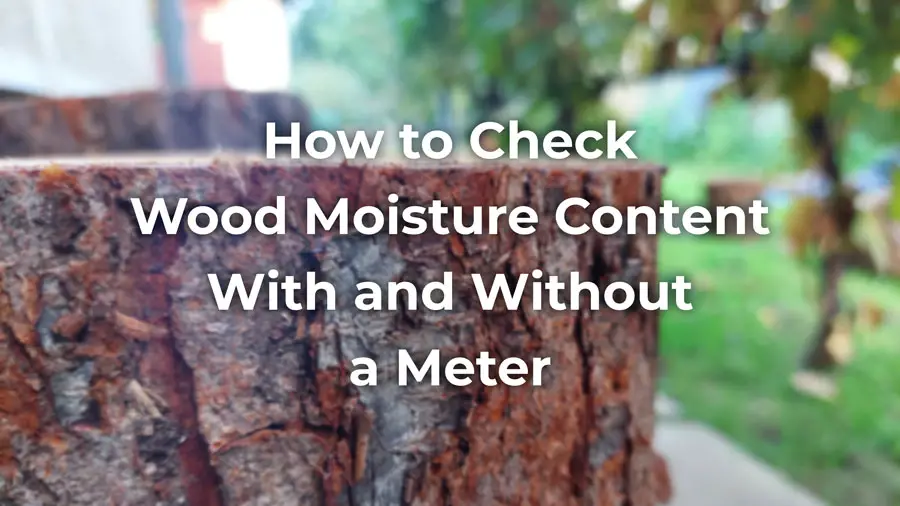No matter what purpose you want to use wood for, you can save yourself a lot of time and annoyance (and probably money), if you use it in a properly dry condition.
Wood is a hygroscopic material which means its weight, volume, and size dynamically change according to the relative humidity of the environment.
This is why it’s so important to check whether your wood is dry enough to burn, for a DIY project or any other purpose.
The easiest and quickest way to measure the moisture content of any wood is to use a moisture meter. If you don’t have a meter, you can calculate the approximate moisture content yourself by speeding up the drying process artificially. Finally, you can also draw useful conclusions about the actual dampness from the appearance of the wood.
Let’s see the details on how you can tell if your wood is ready to use!
How to Check Moisture Content of Wood Using a Meter
Using a wood moisture meter is the standard and most precise way to determine wood moisture content.
A moisture meter is a small, palm-sized battery-powered device that shows the actual wetness of the wood in percentage.
Two main types of moisture meters exist, pin-type and pinless meters.
Pin-type meters have two measuring tips that you need to slightly prick into the wood to get the moisture percentage.
The device uses electric current to determine the resistance of the wood. The higher the resistance, the drier the wood.
A pin meter is perfect in those situations where damaging the wood slightly is not a problem.
Pinless meters can be useful if you need to detect moisture in a non-destructive way. Therefore, a pinless meter can be a reasonable choice for measuring the moisture level of lumber, flooring, and some DIY projects, for example.
It’s somewhat easier to operate than a pin meter, however, it’s usually less precise and costs more.
Keep in mind that most pinless meters should be calibrated for the thickness and type of wood.
I own both types of meters but I usually use the one with pins as in my experience it gives me more accurate results and I mainly need it for measuring the moisture content of firewood (so damaging the wood is not a big deal).
Here’s what it looks like:
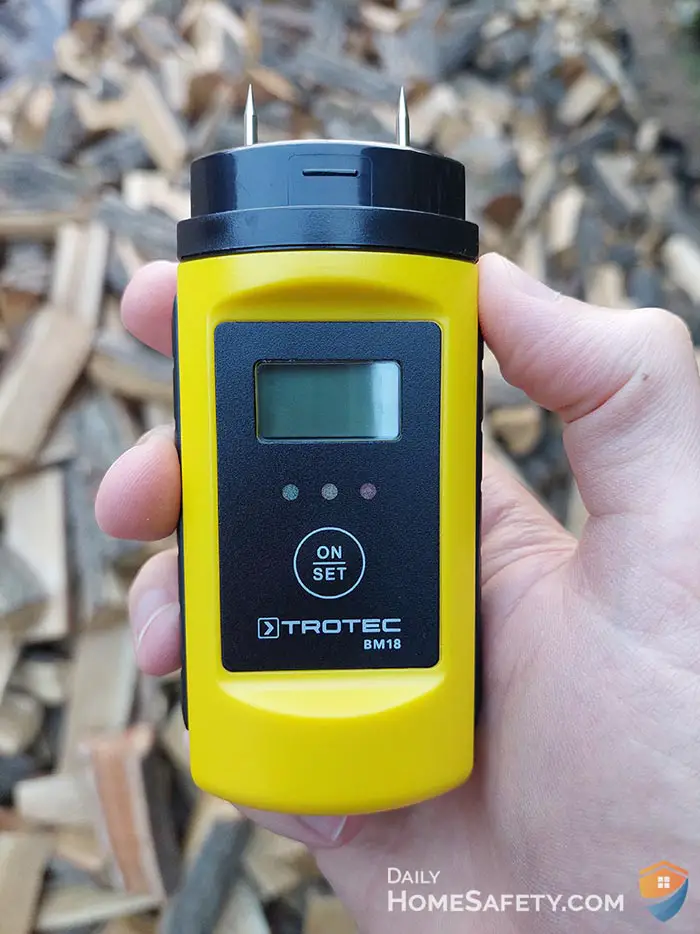
Steps to check moisture content with a meter:
Step 1 – Install the measuring pins (for pin-type models only).
Step 2 – Make sure the batteries are inserted into the device.
Step 3 – Switch on the meter.
Step 4 – Make sure the measurement type is set to wood (some models will even allow you to set the wood type).
Step 5 – Insert the pins into the wood (only for pin-type models) or press the sensor against the surface (for pinless meters).
Step 6 – Read the value from the display.
The above steps may slightly vary depending on the model you use, so make sure you always read the manual as well.
Tip: If you use a pin-type meter, you can improve accuracy by pressing the pins into the wood transverse to the fiber direction. The reason for this is that conductivity parallel to the wood fiber is not the same as transverse to them.
I suggest you always perform several readings to get a more accurate overall picture of the dryness of the different areas of the wood.
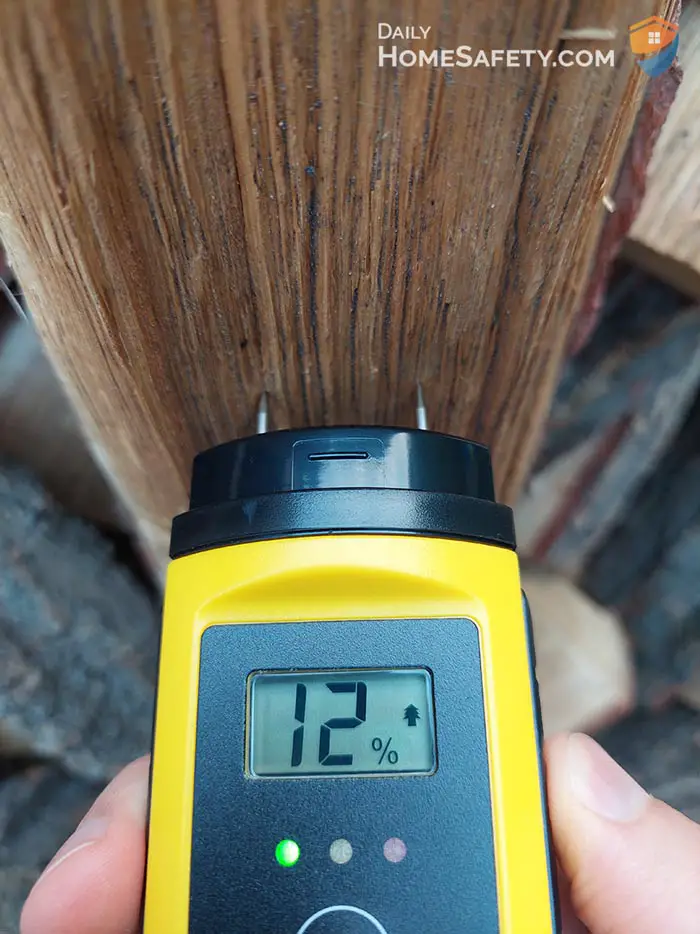
As you can see, by using a moisture meter you can easily tell if the wood you have is too wet in just a few seconds without any hassle. And this is the main benefit of such a device.
Also, it’s a pretty affordable tool: you can get one online or at your local hardware store for under 40 bucks.
How Accurate Is a Wood Moisture Meter?
The accuracy of most moisture meters is quite reasonable. Depending on the actual model, measurement errors typically range from 0.1% to 4%. As I’ve already mentioned, a pin-type meter is generally more accurate than a pinless one.
Measurement errors can be reduced by taking several measurements.
How to Check Moisture Content of Wood Without a Meter
If you don’t have a meter but still want to know the approximate moisture content of your wood, this section is for you.
The following method will give you a relatively accurate result without a moisture meter.
The Oven Drying Method
This proven method is based on the hygroscopic nature of the wood which in simple terms means that wood gives off or absorbs moisture depending on the relative humidity of the surrounding air until reaching an equilibrium.
The simple principle behind the oven drying test is that the damper the wood is, the more it weighs.
So, how does it all work in practice?
Main steps to check moisture content without a meter:
For this test, you’ll need either a kiln or a well-ventilated oven that’s suitable for drying wood.
- Take a small sample of the wood and measure its actual weight.
- Set the thermometer of the oven to 215°F-221°F and start drying the wood (the process will last for several hours, sometimes more than 24 hours depending on the wood species and bound water content).
- Check the actual weight of the wood every few hours to see if there’s any change compared to the previous measurement.
- When you find no difference between your two last measurements, you can turn off the oven and finish the drying process.
- Calculate the moisture content based on the weight of the dried and original samples.
Here’s the formula for the calculation:
wood moisture content (%) = weight of original sample – weight of dried sample / weight of dried sample x 100
Example:
Original wood sample weight: 5.2 pounds
Oven-dried sample weight: 3.9 pounds
Moisture content: 5.2 – 3.9 / 3.9 x 100 = 33.33%
Main drawbacks of this method (important!):
- You need the right type of oven (or kiln) to get reliable results. Not all ovens are suitable for drying wood. For example, without proper ventilation, water won’t be able to leave and that will influence the accuracy of the test negatively. Also, you must be able to control the temperature of the oven and follow fire safety rules to avoid the risk of a fire.
- It’s a hassle. The whole process lasts for hours and requires measurements and calculations. Not the most productive way of using your time.
As you can see, this method requires way more time and effort than using a meter. In my opinion, in most cases, you’ll be better off getting an affordable moisture meter that will be perfect for most use cases, such as DIY wood projects, lumber, wood flooring, or firewood (in addition, many models can also be used for building moisture measurement).
Signs That Wood Is Dry Enough
You don’t always necessarily have to measure the exact moisture content of your firewood to tell if it’s dry enough and ready to burn or use otherwise.
The Dish Soap Test
This test is perfect if you don’t have a meter and you need to quickly check if your firewood is adequately dry to burn.
Pour some dishwashing liquid on one end of a wood log (spread with your finger) and blow hard on the other end with your mouth.
If you see tiny bubbles coming out the opposite end, the firewood can be considered as dry.
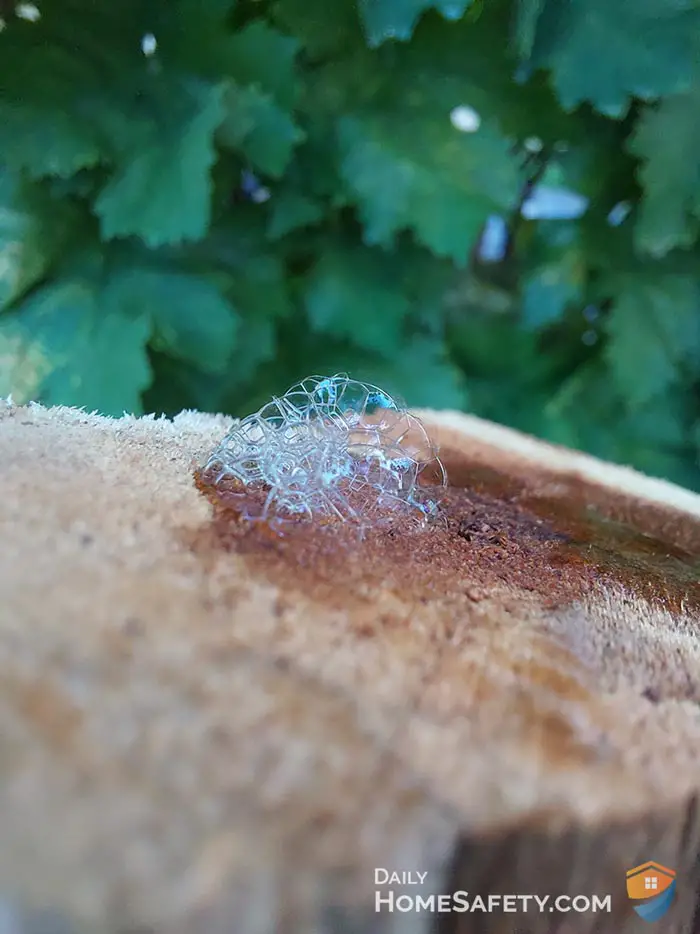
The Banging Test
Dry wood produces a different sound than wet wood when impacted. Thus if you bang two wood logs together at room temperature and hear a ringing sound, chances are good that the wood is quite dry.
However, if the sound you hear is dull and muffled rather than ringing, the wood probably has a high moisture content.
Appearance
If your firewood has been seasoned, in most cases you should see deep cracks at both ends of the logs. This is a direct consequence of aging and drying.
Keep in mind that some wood species, such as plantation pine, can be perfectly dry without cracks showing up at the ends.
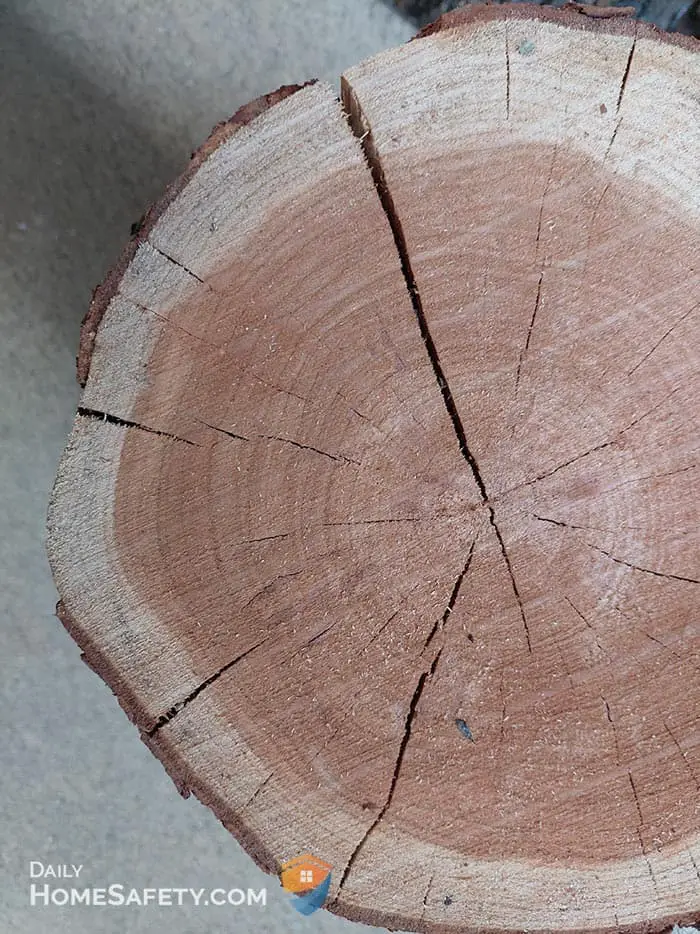
Why Does Moisture Content Matter?
This question often arises. So why should you check wood for moisture content in the first place?
If you use wood as raw material, you always want to make sure the wood is dry enough for the specific purpose because damp wood will shrink considerably over time and may also change its shape and appearance.
The acceptable moisture level depends on what you use the wood for.
For indoor use of lumber, it’s suggested to go as low as 7-8% moisture content.
When it comes to firewood, you don’t want to burn it if the moisture content exceeds 20%.
Seasoned wood is easier to light, and burns more efficiently with less smoke which results in better air quality.
On the other hand, wet firewood produces much more smoke and less heat while burning, so it’s not nearly as efficient as dry wood. Also, burning firewood with high moisture levels may eventually lead to flammable deposits (creosote) in the chimney.
Conclusion
The simplest and quickest way to check the moisture content of wood is to use either a pin-type or pinless moisture meter.
For personal use, such as DIY or firewood, opt for a cheaper model, there’s no need to pay for a professional device. I prefer pin-type meters, as they tend to be more accurate, however, you can’t go wrong with a pinless model either.
If you want to check the wood moisture level without a meter, your best bet is the oven drying method (only if you have the right type of oven or kiln). While it’s slow, it’ll give you a pretty decent approximation when done properly.
If you don’t need an exact number, you can get a fairly good general picture of the wood dryness by examining the appearance of the wood and performing the dish soap and the banging tests.


